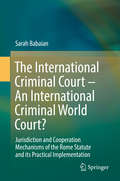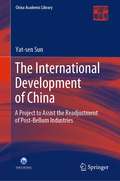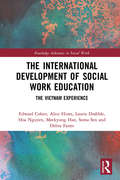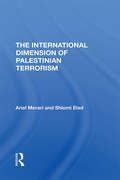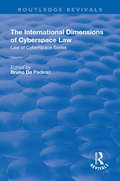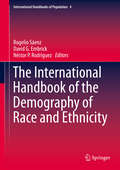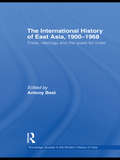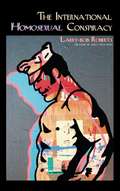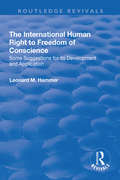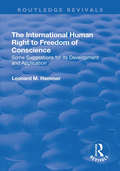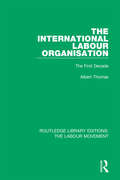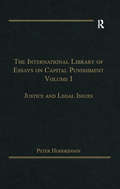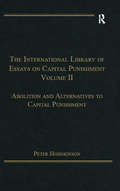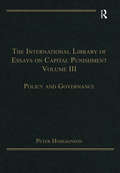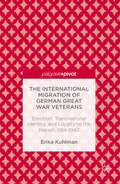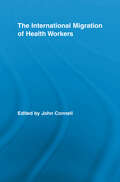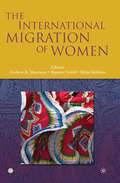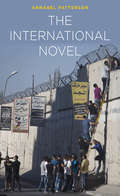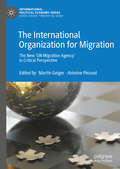- Table View
- List View
The International Criminal Court and the Prosecution of Sitting Heads of State: Democracy, Enforcement, and Symbolism of a Revolutionary Practice in International Politics
by Mattia CacciatoriThe practice of prosecuting sitting Heads of State (SHoS) by the International Criminal Court (ICC) represents a revolutionary and morally compelling pursuit of justice for those who commit the most heinous crimes known to humanity, regardless of their status. This book embarks on an exploration of the intricate political dynamics surrounding this complex practice, delving into six pivotal cases where the ICC grappled with the idea of prosecuting SHoS. These cases include Uganda, Sudan, Kenya, Libya, Syria, and Russia, encompassing all instances where the ICC directly targeted SHoS, as well as two cases where the Court was unable or unwilling to act. The investigation focuses on the multifaceted political complexities involved in initiating investigations against SHoS. It also delves into the far-reaching domestic and international consequences these prosecutions carried, profoundly impacting both the host societies and the international arena.
The International Criminal Court – An International Criminal World Court?: Jurisdiction And Cooperation Mechanisms Of The Rome Statute And Its Practical Implementation
by Sarah BabaianThis book provides an analysis of whether the International Criminal Court can be regarded as an International Criminal World Court, capable of exercising its jurisdiction upon every individual despite the fact that not every State is a Party to the Rome Statute. The analysis is based on a twin-pillar system, which consists of a judicial and an enforcement pillar. The judicial pillar is based on the most disputed articles of the Rome Statute; its goal is to determine the potential scope of the Court’s strength through the application of its jurisdiction regime. The enforcement pillar provides an analysis of the cooperation and judicial assistance mechanism pursuant to the Rome Statute’s provisions and its practical implementation through States’ practices. The results of the analysis, and the lack of an effective enforcement mechanism, demonstrate that the ICC cannot in fact be considered a criminal world court. In conclusion, possible solutions are presented in order to improve the enforcement pillar of the Court so that the tremendous strength of the ICC’s judicial pillar, and with it, the exercise of worldwide jurisdiction, can be effectively implemented.
The International Development of China: A Project to Assist the Readjustment of Post-Bellum Industries (China Academic Library)
by Yat-sen SunThis book presents a rough sketch of Dr. Yat-sen Sun’s (1866-1925) requirements for modernizing China and elaborates on Sun’s desire for the then China to implement a sweeping wave of economic reconstruction and development reforms concerning its railroads and highways, river conservancy and irrigation, new ports and modern cities, by absorbing international capital coming to China. In the preface to this book, first published in 1922, Yat-sen Sun posits, “Unless the Chinese question can be settled peacefully, another world war greater and more terrible than the one just past will be inevitable.” In order to solve the “Chinese question,” he suggested that the country’s vast resources be developed internationally under a socialistic scheme, both for the good of the world in general and the Chinese people in particular. It was his hope that such a scheme would abolish the prevalent spheres of influence of the time, and that the class struggle between capital and labor could be avoided. In this book, Yat-sen Sun presents his solutions for three great questions of global importance: International War, Commercial War and Class War.
The International Development of Social Work Education: The Vietnam Experience (Routledge Advances in Social Work)
by Edward Cohen Hoa Nguyen Alice Hines Laurie Drabble Meekyung Han Soma Sen Debra FairesA robust infrastructure for education and training is vital for the development of an emerging social work education in developing countries. This book fills a gap in the existing literature by providing analysis of international practice methods which can be used by developing countries to develop their own professional and educational infrastructures. The authors’ experience of over eight years in Vietnam in enhancing social work education has yielded important information about the contexts, approaches, and lessons learned when disseminating educational systems and content in non-Western countries. Covering improvements to faculty expertise, university leadership, curriculum, and the use of technology with careful attention to cultural contexts, the chapters describe a model of knowledge transfer which can be generalized to other countries and other fields with emerging professions. International Development of Social Work Education should be considered required reading for all social work academics, students and professionals as well as those working in social and community development.
The International Dimension Of Palestinian Terrorism
by Ariel Merari Shlomi EladTerrorism, by its very nature, is a dynamic and rapidly changing phenomenon. This is particularly true of Palestinian terrorism: it is pluralistic in composition, flourishes in a highly volatile region, and is affected by numerous external actors and elements. Hence any attempt to produce research on Palestinian terrorism of a completely up-to-date nature is doomed to failure. Most of the work on this study was completed by the fall of 1985, and the statistics presented generally cover the period 1968-1984.
The International Dimensions of Cyberspace Law (Routledge Revivals)
by Cyberspace SeriesThis title was first published in 2003. This text is part of the "Law of Cyberspace" series, which deals with the legal aspects of the emerging information society and corresponding ethical matters. The book examines the international dimensions of cyberspace law and the timeliness of drawing up the most appropriate international standard instrument for this environment, exploring ways and means of achieving it and defining the organization's precise role in this respect. The text presents the framework that UNESCO is helping to develop for the international community, with the participation of all the actors in cyberspace, aiming to be ethical, flexible and technologically neutral, multiform, and universal.
The International Film Business: A Market Guide Beyond Hollywood
by Angus FinneyThe International Film Business examines the independent film sector as a business, and addresses the specific skills and knowledge it demands. It describes both the present state of the industry, the significant digital and social media developments that are continuing to take place, and what changes these might effect. The International Film Business: describes and analyses the present structure of the film industry as a business, with a specific focus on the film value chain discusses and analyses current digital technology and how it potentially may change the structure and opportunities offered by the industry in the future provides information and advice on the different business and management skills and strategies includes case studies on a variety of films including The Guard (2011), The King’s Speech (2010), The Best Exotic Marigold Hotel (2012), Cloverfield (2008), Pobby & Dingan (aka Opal Dream, 2005), Confessions of a Dangerous Mind (2002), The Reckoning (2002)and The Mother (2003), and company case studies on Pixar, Renaissance, Redbus and Zentropa. Further case studies on films that failed to go into production include Neil LaBute’s Vapor and Terry Gilliam’s Good Omens. Taking an entrepreneurial perspective on what future opportunities will be available to prepared and informed students and emerging practitioners, this text includes case studies that take students through the successes and failures of a variety of real film companies and projects and features exclusive interviews with leading practitioners in all sectors of the industry, from production to exhibition.
The International Handbook of the Demography of Race and Ethnicity
by Rogelio Sáenz David G. Embrick Néstor P. RodríguezExamining key countries in every region of world, this handbook presents population profiles and analyses concerning racial/ethnic disparities and changing intergroup relations. Inside, prominent scholars from various parts of the world and disciplines address the links between stratification, demography, and conflict across the globe. Organized by region/continent, coverage for each profiled country includes demographic information; a historical overview that addresses past racial/ethnic conflict; identification of the most salient demographic trends and issues that the country faces; theoretical issues related to the linkages between stratification, demography, and conflict; methodological issues including quality of data and cutting-edge methods to better understand the issue at hand; and details on the possible future of the existing trends and issues with particular emphasis on public policy and human rights. This handbook will help readers to better understand the commonalities and differences that exist globally in the interplay between stratification, demography, and conflict. In addition, it also provides an excellent inventory of theoretical perspectives and methodological approaches that are needed to better comprehend this issue. This handbook will appeal to students, researchers, and policy analysts in the areas of race and ethnic relations, demography, inequality, international sociology, international relations, foreign studies, social geography, and social development.
The International History of East Asia, 1900-1968: Trade, Ideology and the Quest for Order (Routledge Studies in the Modern History of Asia)
by Antony BestThis book provides a broad account of the international history of East Asia from 1900 to 1968 - a subject that is essential to any understanding of the modern epoch. Whereas much of the scholarship on this subject has focused purely on the immediate origins and consequences of violent events such as wars and revolutions, this book demonstrates the importance of also considering other forces such as ideology, trade and cultural images that have helped shape East Asian international history. It analyses how the development of the region was influenced by ideological competition and ‘orientalism’, by both multilateral and unilateral efforts to instil order, and by the changing nature of international trade. It considers a number of important topics such as the concept of the ‘open door’; the rise and influence of progressive internationalism in the forum of the League of Nations; the development of anti-colonial nationalism and anti-Western internationalism in the shape of pan-Asianism; and the onset of the Cold War. It also includes detailed case studies of subjects including the administration of the Chinese Maritime Customs Service; the international effort to regulate the trade in opium; and the significance of intra-Asian trade. Overall, this book constitutes an impressive account of the international history of East Asia, and is an important contribution to the interpretive study of this crucial period of history.
The International Homosexual Conspiracy
by Larry-Bob RobertsWith 101 satirical essays, including "I Want to be a Gay Wingnut," "It's Not Easy Being an Arrogant Know-it-all," "Everyone's a Semiotician," and "The Disappearance of the Inexplicable," as well as the title essay, author Larry-bob Roberts has written a laugh-out-loud collection of satirical rants and raves commenting on modern society which would make Jonathan Swift proud.
The International Human Right to Freedom of Conscience: Some Suggestions for Its Development and Application (Routledge Revivals Ser.)
by Leonard HammerThis title was first published in 2002: This text addresses the problem of conflict that arises between the human right to freedom of religion and the human right to freedom of belief, for example, certain religious beliefs are in conflict with certain women's rights. The pricipal goal of this book is to distinguish between the more formalized, and recognized, notion of protecting religious beliefs from what is referred to as conscientious beliefs - a belief external to a religious context.
The International Human Right to Freedom of Conscience: Some Suggestions for Its Development and Application (Routledge Revivals)
by Leonard M HammerThis title was first published in 2002: This text addresses the problem of conflict that arises between the human right to freedom of religion and the human right to freedom of belief, for example, certain religious beliefs are in conflict with certain women's rights. The pricipal goal of this book is to distinguish between the more formalized, and recognized, notion of protecting religious beliefs from what is referred to as conscientious beliefs - a belief external to a religious context.
The International Labour Organisation: The First Decade (Routledge Library Editions: The Labour Movement #40)
by Albert ThomasFirst published in 1931. This study was written by various officials of the International Labour Office, and provides an overview of the work of this institution as it was in the years after its initial formation. The authors provide a full and systematic description of the activities within the organisation, and will be of great interest to scholars and students of political and labour history.
The International Law of Human Trafficking
by Anne T. GallagherAlthough human trafficking has a long and ignoble history, it is only recently that trafficking has become a major political issue for states and the international community and the subject of detailed international rules. This book presents the first-ever comprehensive and in-depth analysis of the international law of human trafficking. Anne T. Gallagher calls on her direct experience working within the United Nations to chart the development of new international laws on this issue. She links these rules to the international law of state responsibility as well as key norms of international human rights law, transnational criminal law, refugee law, and international criminal law, in the process identifying and explaining the major legal obligations of states with respect to preventing trafficking, protecting and supporting victims, and prosecuting perpetrators. This is a timely and groundbreaking work: a unique and valuable resource for policymakers, advocates, practitioners, and scholars working in this new, controversial, and important field.
The International Law of Migrant Smuggling
by Anne T. Gallagher AO Fiona DavidWhether forced into relocation by fear of persecution, civil war, or humanitarian crisis, or pulled toward the prospect of better economic opportunities, more people are on the move than ever before. Opportunities for lawful entry into preferred destinations are decreasing rapidly, creating demand for a range of services that is increasingly being met by migrant smugglers: individuals or criminal groups who facilitate unauthorized entry into in another country for profit. This book, a companion volume to the award-winning The International Law of Human Trafficking, presents the first-ever comprehensive and in-depth analysis of the international law of migrant smuggling. The authors call on their direct experience of working with the United Nations to chart the development of new international laws and to link these specialist rules to other relevant areas of international law, including law of the sea, human rights law, and international refugee law. Through this analysis, the authors identify and explain the major legal obligations of States with respect to migrant smuggling, including those related to criminalization, interdiction and rescue at sea, protection, prevention, detention, and return.
The International Legal Protection of Children in Street Situations (Children’s Well-Being: Indicators and Research #29)
by Sylvia AguThe book conducts a comprehensive analysis of codified international legal instruments and documents in their application to children in street situations, employing soft law documents to elucidate treaty interpretation and supplement existing legal standards. The research adopts a holistic approach, correlating international legal instruments with root causes and consequences for children in street situations, while systematically examining issues of intersectionality, such as economic, social, and cultural rights, civil and political rights, minority rights including disability rights, rights of the girl-child, as well as LGBTQI+ and migrant rights, reparations, impact of violence, and access to essential services like health, food, and housing, with various human rights issues, including economic, social, cultural, and civil-political rights. It presents the plight of children in street situations as a human rights concern, offering guidance on utilising international legal sources in rights claims procedures. The study also integrates sociological and political perspectives with legal and governmental policy issues, examining the influence of external factors such as conditional lending and structural adjustment programmes, wars, and decolonisation on social policies and their consequent impact on children and families by rendering children in street situations 'visible' as a distinct category requiring urgent attention in State policy formulation. By systematically integrating international legal instruments with practical policy considerations and applications concerning children in street situations, this scholarly work serves as a comprehensive legal framework for State governments, their bodies and social workers, and a valuable advocacy guide for interest groups including non-governmental organisations, proposing future directions for policy and research for addressing the rights and needs of children in street situations.
The International Library of Essays on Capital Punishment, Volume 1: Justice and Legal Issues (The International Library of Essays on Capital Punishment)
by Peter HodgkinsonThis volume provides up-to-date and nuanced analysis across a wide spectrum of capital punishment issues. The essays move beyond the conventional legal approach and propose fresh perspectives, including a unique critique of the abolition sector. Written by a range of leading experts with diverse geographical, methodological and conceptual approaches, the essays in this volume challenge received wisdom and embrace a holistic understanding of capital punishment based on practical experience and empirical data. This collection is indispensable reading for anyone seeking a comprehensive and detailed understanding of the complexity of the death penalty discourse.
The International Library of Essays on Capital Punishment, Volume 2: Abolition and Alternatives to Capital Punishment (The International Library of Essays on Capital Punishment)
by Peter HodgkinsonThe essays selected for this volume develop conventional abolition discourse and explore the conceptual framework through which abolition is understood and posited. Of particular interest is the attention given to an integral but often forgotten element of the abolition debate: alternatives to capital punishment. The volume also provides an account of strategies employed by the abolition community which challenges tired methodologies and offers a level of transparency previously unseen. This collection tackles complex but fundamental components of the capital punishment debate using empirical data and expert observations and is essential reading for those wishing to comprehend the fundamental issues which underpin capital punishment discourse.
The International Library of Essays on Capital Punishment, Volume 3: Policy and Governance (The International Library of Essays on Capital Punishment)
by Peter HodgkinsonThis volume provides analyses of a range of subjects and issues in the death penalty debate, from medicine to the media. The essays address in particular the personal complexities of those involved, a fundamental part of the subject usually overridden by the theoretical and legal aspects of the debate. The unique personal vantage offered by this volume makes it essential reading for anyone interested in going beyond the removed theoretical understanding of the death penalty, to better comprehending its fundamental humanity. Additionally, the international range of the analysis, enabling disaggregation of country specific motivations, ensures the complexities of the death penalty are also considered from a global perspective.
The International Migration of German Great War Veterans
by Erika KuhlmanThis book usesstory-telling to recreate the history of German veteran migration after theFirst World War. German veterans of the Great War were among Europe's mostvolatile population when they returned to a defeated nation in 1918, aftergreat expectations of victory and personal heroism. Some ex-servicemen chose toflee the nation for which they had fought, and begin their lives afresh in thenation against which they had fought: the United States.
The International Migration of Health Workers
by Rebecca S. ShahExperts from ethicists and political philosophers to clinicians and trade unionists seek answers to a number of key ethical questions to further a deeper understanding of the ethics of health worker migration.
The International Migration of Health Workers (Routledge Research in Population and Migration)
by John ConnellThis volume provides the first detailed overview of the growing phenomenon of the international migration of skilled health workers. The contributors focus on who migrates, why they migrate, what the outcomes are for them and their extended families, what their experiences in the workforce are, and ultimately, the extent to which this expanding migration flow has a relationship to development issues. It therefore provides new, interdisciplinary reflections on such core issues as brain drain, gender roles, remittances and sustainable development at a time when there has never been greater interest in the migration of health workers.
The International Migration of Women
by Maurice Schiff Andrew R. Morrison Mirja SjöblomThe current share of women in the world's international migrant population is close to one half. Despite the great number of female migrants and their importance for the development agenda in countries of origin, there has until recently been a striking lack of gender analysis in the economic literature on international migration and development. This volume makes a valuable contribution in this context by providing eight new studies focusing on the nexus between gender, international migration, and economic development.
The International Novel
by Annabel PattersonAnnabel Patterson here turns her well-known concern with political history in early modern England into an engine for investigating our own era and a much wider terrain. The focus of this book is, broadly, nationalism and internationalism today, approached not theoretically but through the lens of fiction. Novels are uniquely capable of dealing with abstract problems by embodying them in the experience of persons, thereby rendering them more "real." Patterson takes twelve novels from (almost) all over the world: India, Africa, Turkey, Crete, the Balkans, Palestine, Afghanistan, South America, and Mexico, novels which illustrate the dire effects of some of the following: imperialism, partition, annexation, ethnic and religious strife, boundaries redrawn by aggression, the virus of dictatorships, the vulnerability of small countries, and the meddling of the Great Powers. All are highly instructive, and excellent reads.
The International Organization for Migration: The New ‘UN Migration Agency’ in Critical Perspective (International Political Economy Series)
by Antoine Pécoud Martin GeigerIn 2016, the International Organization for Migration (IOM) became part of the United Nations. With 173 member states and more than 400 field offices, the IOM—the new ‘UN migration agency’—plays a key role in migration governance. The contributors in this volume provide an in-depth and comprehensive insight into the IOM, its transformation, current structure and projects, as well as its capacity, self-understanding and political agenda.

